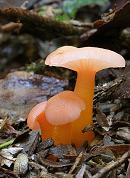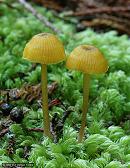The very nature of fungi and there habitats creates a real challenge when it comes to photographing them. Dark damp forest floors are not the place for cameras.
One advantage we have is nothing in the New Zealand's bush is going to bite back other then mosquitoes. there is the odd plant that can be a nuisance like bush lawyer and steeple jack but these are easily recognised and avoided. The biggest danger is getting lost of track someting that I have done several times and now cary some servival equipment.
After photographing fungi for some time now, I have come to the conclusion that you don't take good fungi photos, but find them. A fungus that is mature, not damaged by insects, that's out in the open with plenty of available light, and not covered in dirt or leaf litter should, with the skill of the photographer, produce a good photograph.
On the other hand, one found in a dark, restricted area that is damaged by insects or rain will never give a good result. So, to get good fungi photos, be prepared to invest plenty of time in searching for good quality specimens in ideal locations. This alone is no easy task, as I go out during the season twice most weekends and may only find 10 quality specimens each season.
Fortunately for me, any time I go bush and come home with a photograph of a species I have not found before is a good day, but as time goes on, it gets harder and harder to do this:)

